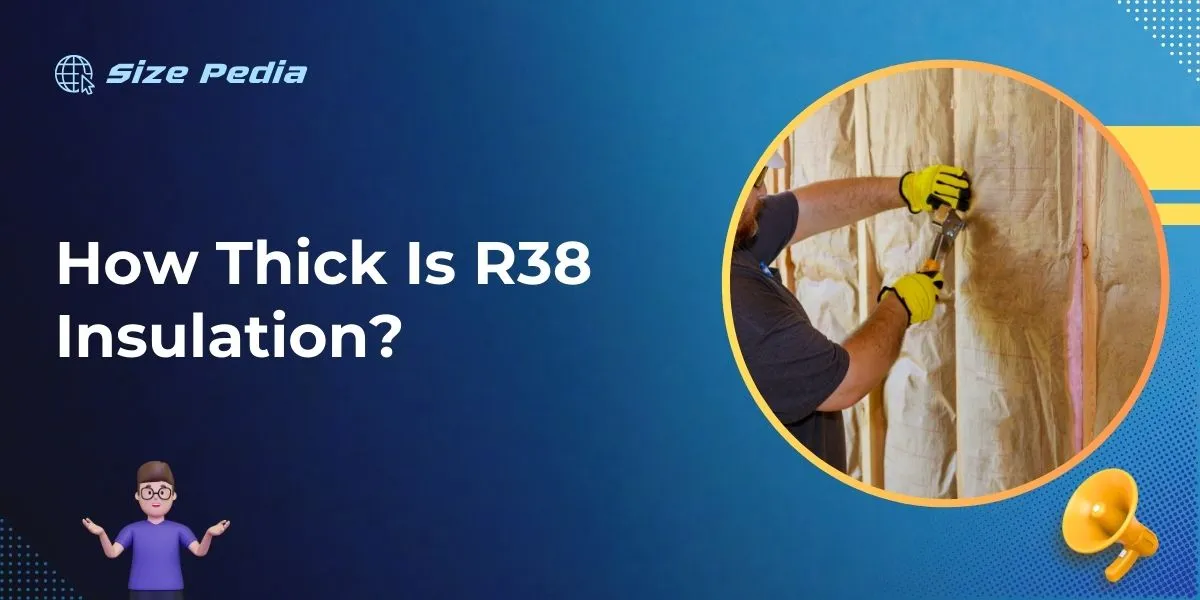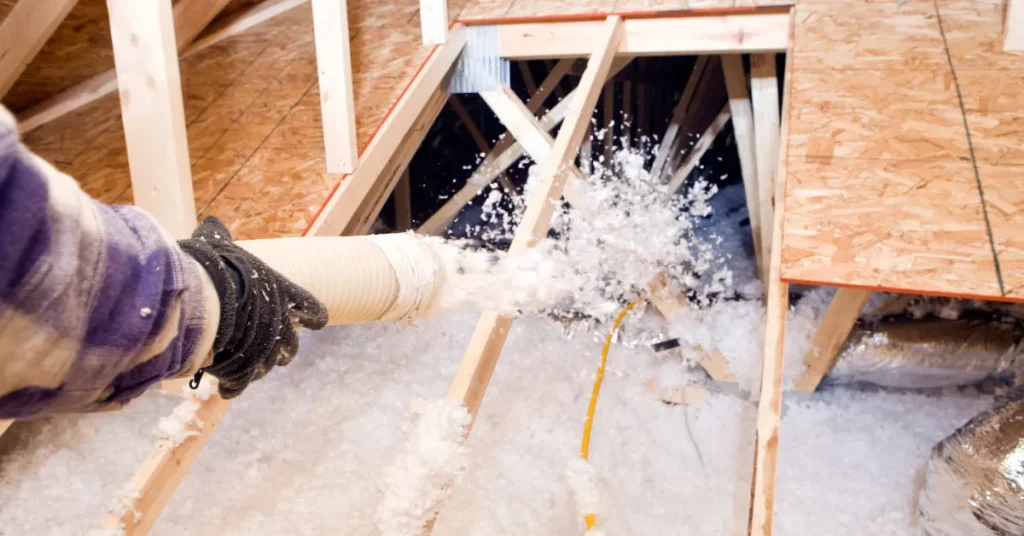R38 insulation typically measures about 12 inches thick. This depth helps it achieve its high thermal resistance value.
Insulating a home properly is crucial for maintaining energy efficiency and comfort throughout the seasons.
R38 insulation is often recommended for attic spaces, where it can significantly reduce the exchange of heat between the home’s interior and the outside environment.
This level of insulation is especially important in regions with extreme temperatures, both hot and cold.
A well-insulated attic can lead to lower heating and cooling costs and a more stable indoor climate, making it an investment that homeowners will benefit from year after year.
Choosing R38 insulation is a smart move for those looking to improve their home’s energy performance and reduce their environmental footprint.

The Role Of R-values In Insulation
Understanding the thickness of R38 insulation starts with grasping R-values. R-values measure how well insulation can resist heat flow.
They are pivotal figures that help determine the effectiveness of insulation materials in keeping buildings warm or cool, making them crucial for energy efficiency.
Insulation with higher R-values generally means better thermal resistance, resulting in greater energy savings.
Measuring Thermal Resistance
When discussing insulation, it’s vital to talk about R-values. These values are dictated by material type, thickness, and density. R-values are not the same as inches of thickness. Yet, greater thickness often indicates a higher R-value.
- Material: Different insulating materials have unique R-values.
- Density: More compact insulation can yield a higher R-value.
- Thickness: A thicker layer of insulation typically offers more resistance to heat flow.
For instance, R38 insulation has an R-value of 38. This rating tells us that the material has a high level of thermal resistance.
Comparing Different R-values
Insulation products come in varied R-values to meet different needs. It’s essential to compare these values to select the right insulation for a space. The R-value needed can depend on climate and where the insulation will go in a building.
| Insulation Type | R-Value Range | Common Uses |
| Low | R1 to R20 | Interior walls, floors |
| Medium | R21 to R38 | Attics, basements, external walls |
| High | R38 and above | Extreme climates, special applications |
Let’s take a closer look at R38 insulation. It falls within the medium range, suitable for areas that need substantial insulation, like attics. With its R-value of 38, such insulation does an exceptional job in most residential settings.
To ensure year-round comfort and energy efficiency in a home, proper R-values are critical. Choosing the right R-value, like R38 for an attic space, can make a significant difference in a building’s thermal performance and utility bills.
Decoding The R38 Insulation Label
When it’s time to insulate a home, R38 insulation often comes into the conversation. But what exactly is R38 insulation? Let’s unpack the meaning behind the label and see why it’s a go-to choice for thermal insulation.
Materials Used In R38 Insulation
R38 insulation comes in various materials, each with unique benefits. Common types include fiberglass, rock wool, and cellulose.
- Fiberglass: Made from fine glass fibers and is most popular.
- Rock Wool: Also known as mineral wool, made from basalt or slag.
- Cellulose: Consists of recycled paper products and is eco-friendly.
Understanding Its Thermal Performance
An R38 rating indicates high thermal resistance. This insulation is commonly used in areas requiring high-energy efficiency. In practice, this means it retains heat well, keeping spaces warm in winter and cool in summer.
| R-Value | Efficiency |
| R38 | High thermal resistance |
Typically, R38 insulation is around 12 to 18 inches thick, although this can vary based on the material type and density, affecting its overall performance.
Determining The Thickness Of R38 Insulation

Insulation matters when keeping homes warm or cool. Many ask about the thickness of R38 insulation. This guide helps understand what to expect from R38.
Standard Thickness Measurements
How thick is R38 insulation? R38 refers to the insulation’s R-value, a measure of resistance to heat flow. The higher the R-value, the better the insulation performs.
- Fiberglass batts: around 12 inches
- Blown-in fiberglass or cellulose: can vary, often 10 to 14 inches
- Spray foam: varies by type but is typically 6 to 7 inches for closed-cell foam
Factors That Affect Thickness
Several factors can change thickness. These include:
| Factor | Effect on Thickness |
| Material Type | Different materials have different thicknesses for the same R-value. |
| Installation Method | How the insulation is put in can change the thickness needed. |
| Climate Zone | In colder areas, thicker insulation might be needed to reach R38. |
| Airflow | Spaces with more airflow might need thicker insulation to maintain R38. |
Knowing these will help you get the right insulation. A professional can give advice tailored to your home.
Application Areas For R38 Insulation
An important aspect of home insulation involves understanding where R38 insulation fits best. This type of insulation is thick and has specific uses. Below, we’ll explore the applications and where this material is most effective.
Ideal Climate Conditions For R38 Insulation
R38 insulation is perfect for areas with extreme weather. It keeps homes warm in cold climates and cool in hot climates. Its thickness provides a high R-value, which means better insulation performance.
Typical Installation Locations For R38 Insulation
R38 insulation is often used in key areas of a house. These areas need extra insulation to maintain a comfortable home environment. See the common locations below:
- Attics: Attics can lose a lot of heat. R38 keeps that heat inside.
- Ceilings with attic spaces above: This helps prevent heat exchange through the ceiling.
- Floors over unheated garages: Insulation here prevents cold garage air from chilling the floor above.
- Vaulted ceilings: The thickness of R38 fills the space and insulates effectively.
A house may have other specific needs. Always check with a professional to see where R38 is best for your home.
Maximizing Efficiency With R38 Insulation
Understanding R38 insulation helps homeowners make smart choices. R38 insulation typically measures about 12 inches thick.
This thickness is crucial for achieving top-notch thermal performance. Properly installed, it keeps homes cozy during winter and cool in summer.
Installation Best Practices
Good installation is key to maximizing R38 insulation benefits. Follow these practices:
- Measure space accurately to cut insulation to size.
- Avoid compression to maintain the insulation’s effectiveness.
- Seal all gaps and spaces to prevent air leaks.
- Use protective gear for a safe installation.
- Check local building codes for specific requirements.
Ensuring Long-term Energy Savings
R38 insulation is a long-term investment. To ensure energy savings:
- Maintain the insulation by checking for sagging or moisture.
- Upgrade over time as needed to retain energy efficiency.
- Combine with other energy-saving measures for best results.
Comparing R38 With Other Insulation Options

R38 insulation stands out for its thickness and efficiency. This type of insulation is designed to provide superior thermal resistance, commonly referred to as R-value. The higher the R-value, the better the material’s insulating power.
R38 insulation is often recommended for areas with extreme weather conditions because of its ability to maintain stable indoor temperatures.
Let’s delve into how R38 compares with other popular insulation options and explore when it’s the smartest choice for your home or building.
When To Choose R38 Over Others
Selecting the right insulation depends on your unique needs.
- Climate: R38 is ideal for very cold or hot areas.
- Space: R38 is thicker, requiring more room.
- Energy savings: High R-value equals more savings.
R38 insulation works best in attics, roofs, and floors where space allows for thicker materials, warranting better energy efficiency. In contrast, tighter spaces might benefit from insulation with a lower R-value but thinner profile, like R19 or R13.
Cost-benefit Analysis Of Insulation Types
Evaluating insulation must include both initial cost and long-term savings.
| Insulation Type | Thickness | Cost | Long-Term Savings Potential |
| R38 | Approximately 12-16 inches | Higher upfront cost | Significant due to high R-value |
| R30 | Approximately 9-12 inches | Medium upfront cost | Moderate |
| R19 | Approximately 6 inches | Lower upfront cost | Lesser than R38 and R30 |
Comparing these options, R38 insulation offers the best thermal resistance and potential energy savings, yet it comes at a higher initial investment.
Consider the balance between the upfront cost and the long-term energy savings when choosing the right insulation type for your project.
FAQs About How Thick Is R38 Insulation
How Many Inches Of Loose Fill Insulation Do I Need?
The recommended depth for loose fill insulation varies, with 10 to 14 inches often needed for optimal energy efficiency in attics.
Is R38 Insulation Worth It?
R38 insulation is valuable for enhancing energy efficiency and comfort in homes, particularly in colder climates with high heating demands. Its higher R-value provides better thermal resistance, potentially leading to reduced energy bills.
How Thick Is Owens Corning R-38?
The Owens Corning R-38 insulation has a thickness of approximately 12 inches.
How Thick Is R30 Attic Insulation?
R30 attic insulation typically has a thickness of about 9. 5 to 10 inches. This ensures effective thermal resistance for home energy efficiency.
Conclusion
Wrapping up our discussion on R38 insulation, remember it boasts a typical thickness around 12 inches. This depth is key for optimal thermal resistance in various climates.
For energy-efficient homes, choosing R38 is a smart move. Ready to upgrade your space?
Consider R38 for comfort and savings year-round.
Resources:
1. https://www.energystar.gov/saveathome/seal_insulate/identify-problems-you-want-fix/diy-checks-inspections
